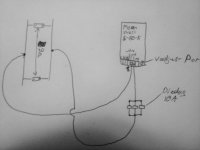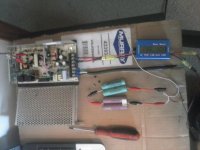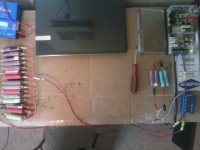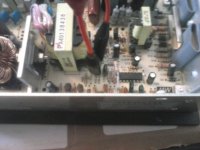diggler
1 kW
Thanks For the reply Dr. K
Yes for the most part it required constant monitoring and adjusting...
The hotter the diodes were/more current draw, the more voltage drop there was across them.
Originally I thought it would be more consistent.
Interesting I used 12 gauge wire and I thought it was rated to 30A...wire never got hot unless it was by the diodes.
Isn't there always a voltage drop when current passes through a diode? (Side affect of turning diode on)
I have 10 gauge but was going to save that for the battery because my 1000W motor will draw 45A max, and 10 gauge is rated to 45A right?
In the beginning of the charge the voltage on the meanwell terminals was well over 5v, with a voltage drop ~1v across the diodes in the positive lead. On precharged cells ~4.05-4.1v.
By the end of the charge voltage on meanwell terminals was ~4.42v and at the end of the charging leads hooked to cells there was 4.15v. (which at this point the Amp draw was very little.)
Okay! :lol:... This would be great! I want it to be set at 30A max output.
I have read the article...
Okay I want to do the R25 mod...So just solder in another 1K resistor in series with the R25. (prob use a 30w soldering iron?)
This is my main concern with modding the meanwell. I don't have a proper amp meter for reading the current. (I should just buy a inductive lead amp meter multi meter.) But I really don't need anymore current then 30A so soldering another resistor in series to the R33 or R38 would be ideal....
Or wait lowering the ohms makes for lower Amps right? Idk It's hard to tell from the article...
To lower the ohm value would I cut both resistors out and solder in one lower ohm resistor in parallel to both resistor pos. and neg points? Or would I have to keep the R33 and R38 circuits separate and solder in one lower resistor on each resistor pos. and neg. points? Or would I just have to mess with one of them?
What are the values of the R33 and R38 in ohms? I just took the cover off I guess I could check them. Still don't know which way to go...
P.S. I doesn't say in the S-150-5 wiki article to solder in a 1k resistor in series to the R25 resistor. It said in series to the factory pot.
Also it is my under standing that voltage "sag" and voltage "drop" are two different things. Voltage sag is battery/power supply voltage before applying a load compared to battery/power supply voltage after initially applying a load. Voltage drop is how much voltage drops when crossing a load or connection or length of wire. Right? NBD I know what you mean.
Thanks again on all your advice!
"DrkAngel wrote"
Typically, running Diodes in parallel produces "unreliable" results.
Interesting that you got things working.
Yes for the most part it required constant monitoring and adjusting...
The hotter the diodes were/more current draw, the more voltage drop there was across them.
Originally I thought it would be more consistent.
Likely, small gauge wire is responsible for your noticed voltage sag.
MeanWell S-150-5 at 5V 30A would want 10AWG-ga-gauge copper wire to maintain 30 amp throughput ... without noticeable voltage sag.
Interesting I used 12 gauge wire and I thought it was rated to 30A...wire never got hot unless it was by the diodes.
Isn't there always a voltage drop when current passes through a diode? (Side affect of turning diode on)
I have 10 gauge but was going to save that for the battery because my 1000W motor will draw 45A max, and 10 gauge is rated to 45A right?
Remember though ...
Without modding, MeanWell S-150-5 is current limited at ~40A, (at 4.15V x 40A = 166w), will allow entire unit to overheat, ... so setting for final voltage and using lighter gauge charging leads ... might be a good thing?
In the beginning of the charge the voltage on the meanwell terminals was well over 5v, with a voltage drop ~1v across the diodes in the positive lead. On precharged cells ~4.05-4.1v.
By the end of the charge voltage on meanwell terminals was ~4.42v and at the end of the charging leads hooked to cells there was 4.15v. (which at this point the Amp draw was very little.)
But, don't be afraid to mod the MeanWell!
Okay! :lol:... This would be great! I want it to be set at 30A max output.
ES Wiki article - MeanWell S-150-5 mods
I have read the article...
Swapping voltage pot from 1k to 2k will allow voltage adjustment from ~3.75V to 5.4V.
Or the R25 mods ... upping R25 value 1k would change oem voltage adjustment to a more accurate 3.75V - 4.5V.
Okay I want to do the R25 mod...So just solder in another 1K resistor in series with the R25. (prob use a 30w soldering iron?)
Sorry, I have not figured the values for the current mods yet. - Had to rig a <5V 50A digital meter
This is my main concern with modding the meanwell. I don't have a proper amp meter for reading the current. (I should just buy a inductive lead amp meter multi meter.) But I really don't need anymore current then 30A so soldering another resistor in series to the R33 or R38 would be ideal....
Or wait lowering the ohms makes for lower Amps right? Idk It's hard to tell from the article...
To lower the ohm value would I cut both resistors out and solder in one lower ohm resistor in parallel to both resistor pos. and neg points? Or would I have to keep the R33 and R38 circuits separate and solder in one lower resistor on each resistor pos. and neg. points? Or would I just have to mess with one of them?
What are the values of the R33 and R38 in ohms? I just took the cover off I guess I could check them. Still don't know which way to go...
P.S. I doesn't say in the S-150-5 wiki article to solder in a 1k resistor in series to the R25 resistor. It said in series to the factory pot.
Also it is my under standing that voltage "sag" and voltage "drop" are two different things. Voltage sag is battery/power supply voltage before applying a load compared to battery/power supply voltage after initially applying a load. Voltage drop is how much voltage drops when crossing a load or connection or length of wire. Right? NBD I know what you mean.
Thanks again on all your advice!






